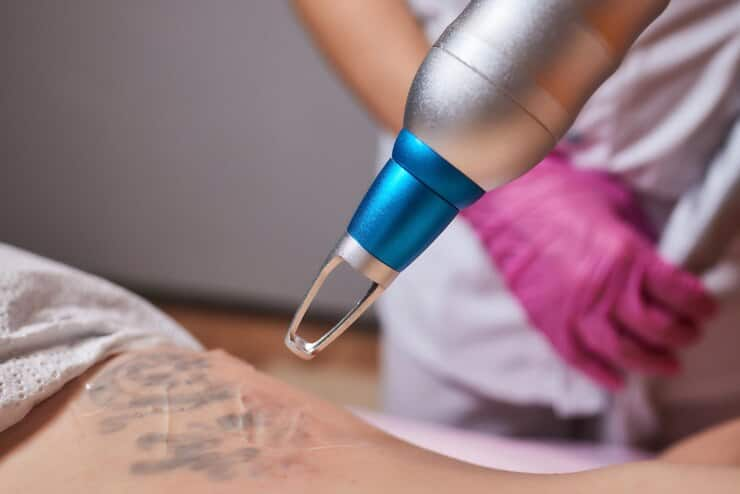Laser tattoo removal has become an increasingly popular method for those looking to erase unwanted ink from their skin. In Manchester, this non-invasive procedure provides a safe and effective solution, helping individuals regain confidence in their appearance. Understanding how laser technology works, what to expect during treatment, and how to care for your skin afterward can help ensure optimal results. Laser tattoo removal in Manchester offers a safe, effective, and minimally invasive solution for those looking to erase unwanted tattoos.
Understanding Laser Tattoo Removal
What is Laser Tattoo Removal
Laser tattoo removal is a procedure that uses concentrated beams of light to break down tattoo ink particles beneath the skin. Unlike traditional methods such as surgical excision or dermabrasion, laser treatment targets the ink without causing significant damage to surrounding tissue. The body’s immune system then gradually eliminates these fragmented particles, resulting in the fading and eventual removal of the tattoo.
How the Laser Works
The laser emits high-intensity light pulses that are absorbed by the pigments in the tattoo ink. Different wavelengths are used to target different colors, as certain pigments respond better to specific light frequencies. Black ink absorbs all wavelengths effectively, making it the easiest to remove, while colors like green and blue may require more specialized lasers and additional sessions.
The Safety of Laser Tattoo Removal
Non-Invasive Procedure
One of the main advantages of laser tattoo removal is its non-invasive nature. The procedure does not require cutting, stitching, or removing layers of skin, reducing the risk of scarring and infection. Each treatment session is carefully controlled, with the energy level of the laser adjusted according to the tattoo's size, location, and color.
Minimizing Risks
Proper consultation and assessment prior to treatment are essential to minimize risks. A trained professional will evaluate the tattoo, skin type, and any medical conditions to determine the most appropriate approach. Protective measures, such as shielding surrounding skin and providing eye protection, further ensure the procedure is conducted safely.
The Laser Tattoo Removal Process
Consultation and Assessment
Before starting treatment, individuals undergo a detailed consultation. This includes discussing medical history, tattoo details, and desired outcomes. Professionals may also take photographs to monitor progress and advise on realistic expectations. Understanding the process and potential results helps individuals make informed decisions.
Treatment Sessions
Laser tattoo removal typically requires multiple sessions spaced several weeks apart. The number of sessions depends on factors such as the tattoo's age, color, ink depth, and individual skin response. During the session, the laser handpiece is applied directly to the tattooed area, delivering controlled pulses of light. Patients may feel a sensation similar to a rubber band snapping against the skin, but numbing creams can be used to enhance comfort.
Healing and Aftercare
After each session, the treated area may be slightly red, swollen, or sensitive. Applying cold compresses and following post-treatment instructions helps minimize discomfort and reduce the risk of complications. It is crucial to keep the area clean, avoid direct sun exposure, and refrain from picking or scratching the skin. With proper care, healing is typically quick, allowing individuals to continue with subsequent sessions as scheduled.
Factors Affecting Laser Tattoo Removal
Tattoo Age and Ink Quality
Older tattoos often fade more easily because the ink particles have already broken down over time. In contrast, newer tattoos may require more sessions for complete removal. Professional tattoos usually contain denser, more vibrant ink, which can influence the number of treatments needed. Amateur tattoos may be easier to treat but can have uneven ink distribution.
Skin Type and Location
Skin type plays a role in how effectively the laser breaks down ink. Lighter skin tones generally show faster results, while darker skin may require specialized lasers to minimize the risk of pigmentation changes. The location of the tattoo also matters, with areas that have better blood circulation typically healing and fading more efficiently.
Color and Ink Composition
Different ink colors respond differently to laser treatment. Black ink is the most responsive, while colors like green, yellow, and blue may require specific wavelengths for effective removal. Multi-colored tattoos often need a combination of lasers to address each color safely and efficiently.
Benefits of Laser Tattoo Removal
Gradual and Controlled Fading
Laser technology allows for precise targeting of tattoo ink, enabling gradual fading over multiple sessions. This controlled process reduces the risk of scarring and ensures a natural-looking result. Individuals can monitor the progress and decide when they are satisfied with the level of removal.
Minimal Side Effects
Compared to traditional removal methods, laser treatment has minimal side effects. Temporary redness, swelling, or blistering may occur, but these typically resolve within a few days. The non-invasive nature of the procedure preserves surrounding skin, making it a preferred choice for safe tattoo removal.
Restoring Skin Appearance
Laser tattoo removal can restore the skin’s natural appearance, allowing individuals to feel more confident and comfortable in their own skin. Whether removing a small symbolic tattoo or a large, intricate design, the treatment can help achieve the desired cosmetic outcome without extensive downtime.
Preparing for Laser Tattoo Removal
Choosing a Qualified Professional
Selecting a trained and experienced professional is crucial for safe and effective laser tattoo removal. Expertise in different laser types, skin assessments, and treatment planning ensures the procedure is tailored to individual needs and reduces the risk of complications.
Pre-Treatment Guidelines
Before treatment, individuals should avoid sun exposure, tanning products, and certain medications that can increase skin sensitivity. Keeping the skin hydrated and following the professional’s instructions helps prepare the area for laser sessions and promotes better results.
Conclusion
By understanding how the procedure works, following professional guidance, and adhering to proper aftercare, individuals can achieve remarkable results with minimal risks. For those seeking expert advice and treatment options, Este Medical Group provides professional consultations and advanced laser technology to help you safely and efficiently remove tattoos. Take the first step toward clearer skin and renewed confidence today.





Comments